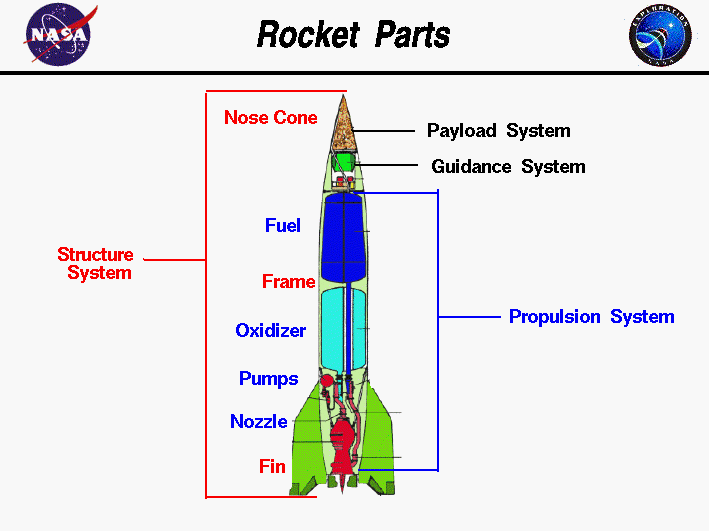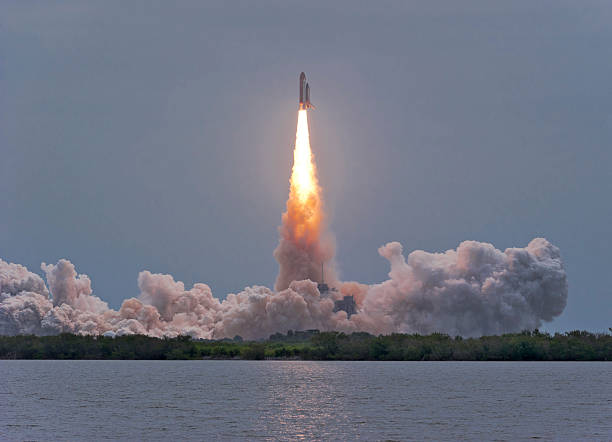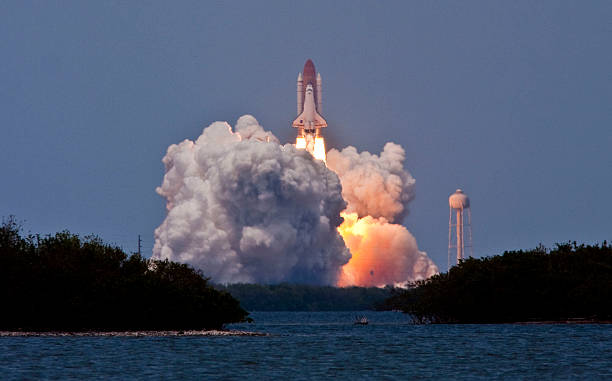Rocket propulsion is the driving force behind the successful launch and operation of space rockets. Understanding the science behind how rockets work is crucial for engineers and scientists involved in the design and development of these incredible machines. Rocket propulsion refers to the process by which a rocket engine generates the force needed to overcome Earth’s gravity and propel the spacecraft into space.
At the heart of every rocket is a rocket engine, which is responsible for converting fuel into thrust. The rocket engine consists of a combustion chamber and a nozzle. The rocket fuel, typically a combination of liquid or solid propellants, burns with an oxidizer in the combustion chamber to produce a high-temperature, high-pressure gas. This gas then exits the combustion chamber through the nozzle, which accelerates the gas and directs it in a specific direction, generating thrust. By exerting action-reaction forces, the escaping gas propels the rocket forward and upward during space launch.
ALSO READ: Silent on Mars: NASA Loses Contact with Ingenuity Helicopter
The Basics of Rocket Engines: A Closer Look at Rocket Propulsion
Rocket engines are the heart and soul of space exploration, powering the incredible journeys of spacecraft venturing beyond Earth’s atmosphere. At their core, rocket engines rely on a fundamental principle of physics – action and reaction. By ejecting high-velocity exhaust gases, these engines generate an equal and opposite force, propelling the spacecraft forward. This principle enables rockets to overcome gravity and achieve escape velocity, the speed required to break free from Earth’s gravitational pull and reach the vast expanses of space.
To accomplish this feat, rocket designs typically involve multiple stages. Each stage consists of its own engine and propellant, contributing to the overall thrust needed for the journey. As the rocket ascends, it sequentially jettisons the stages, shedding weight and increasing efficiency. This modular design maximizes the spacecraft’s ability to achieve escape velocity and efficiently navigate through the void. Additionally, rocket guidance plays a crucial role in ensuring the spacecraft follows its intended trajectory. Advanced guidance systems, coupled with thrust vectoring techniques, allow for precise positioning and course corrections, helping the spacecraft maneuver accurately towards its destination amidst the vastness of space.
The utilization of rocket engines, the strategic implementation of multiple stages, and the precise guidance systems are all vital components in space exploration. These technologies enable us to push the boundaries of human knowledge and expand our understanding of the universe. As we continue to push the limits of space exploration, the advancement of rocket engine technology will undoubtedly play a crucial role in the future of human space travel and the discovery of celestial wonders that lie beyond our planet’s reach.
The Role of Rocket Fuel and Oxidizer in Launching Spacecraft

Thrust is a crucial component in the propulsion of space rockets. Rocket engines generate thrust by following the principles of action and reaction, as stated by Newton’s third law of motion. The role of rocket fuel and oxidizer in launching spacecraft is to provide the necessary propellant for generating this thrust.
Engineers carefully choose rocket fuel and oxidizer to maximize the efficiency and power of the rocket engine. Rocket fuel is typically a chemical compound that releases a large amount of energy when it reacts with an oxidizer. This energy is harnessed in the combustion chamber, where the fuel and oxidizer are mixed and ignited. The combustion process produces high-pressure and high-temperature gases that are expelled through the nozzle, creating a powerful stream of exhaust gases. It is this expulsion of gases in one direction that generates the equal and opposite reaction, propelling the rocket forward.
The selection of rocket fuel and oxidizer is crucial for achieving the desired performance and efficiency. Different types of propellants have varying energy densities and combustion characteristics, which directly impact the thrust and overall performance of the rocket engine. Additionally, the oxidizer plays a critical role in the combustion process, providing the necessary oxygen for the fuel to burn. The ratio of fuel to oxidizer, known as the stoichiometric ratio, must be carefully determined to ensure complete combustion and optimal performance. Therefore, the careful combination and precise control of rocket fuel and oxidizer are vital for achieving the efficient and powerful propulsion required for launching spacecraft into space.
From Combustion Chamber to Nozzle: Exploring the Inner Workings of a Rocket Engine

The combustion chamber is at the heart of a rocket engine, where the controlled explosion takes place. This critical component houses the ignition system, fuel injectors, and oxidizer injectors. With careful precision, the fuel and oxidizer mix in the combustion chamber, creating a highly combustible mixture. As the mixture ignites, the high-pressure gases generated push against the walls of the chamber, initiating the release of energy. The intense heat and pressure force the expanding gases through the nozzle, a tapered channel that accelerates the gases and controls their flow.
As the gases pass through the nozzle, they experience a change in velocity due to the Venturi effect. This phenomenon occurs as the gases travel from a wider cross-sectional area in the combustion chamber to a narrower exit at the nozzle’s throat. The convergent-divergent shape of the nozzle contributes to this change in velocity, allowing for optimal flow conditions. The rapid expansion of gases through the nozzle creates a powerful thrust, propelling the rocket forward and overcoming the force of gravity. By achieving escape velocity, the rocket is able to break free from Earth’s gravitational pull and venture into space. Moreover, once in space, a rocket must reach orbital velocity, which is the speed required to maintain a stable orbit around a celestial body.
Overcoming Gravity: How Rockets Achieve Escape Velocity
To overcome the powerful force of gravity and reach escape velocity, rockets employ a variety of mechanisms and technologies. One of the key elements is the use of multi-stage rocket systems. These rockets are comprised of two or more stages stacked on top of each other. Each stage consists of its own engines and propellant tanks. As the first stage burns through its fuel, it eventually reaches a point where its thrust is no longer sufficient to propel the entire rocket. At this critical moment, stage separation occurs, and the depleted stage is jettisoned to shed weight and increase efficiency.
In addition to the multi-stage design, rockets rely on sophisticated guidance systems and gyroscopes to maintain stability and ensure accuracy during the ascent. A guidance system serves as the “brain” of the rocket, constantly monitoring and adjusting the rocket’s trajectory to maintain the desired path. Gyroscopes, on the other hand, play a crucial role in providing a stable reference frame that helps stabilize the rocket against external forces. By combining the information from the guidance system and gyroscopes, the rocket’s onboard computers can make precise adjustments, utilizing a technique known as thrust vectoring. This mechanism controls the direction of thrust by manipulating the nozzle of the rocket engine, allowing the rocket to overcome gravity and achieve the necessary thrust to reach escape velocity.
Space Launch: Unleashing the Power of Thrust and Action-Reaction

Space launches are no small feat. The power of thrust and action-reaction plays a crucial role in propelling spacecraft into space. Whether it’s a satellite launch, a space probe, or a planetary mission, the ability to generate enough thrust to overcome Earth’s gravity is essential. Engineers and scientists have spent decades perfecting rocket technology to maximize the efficiency and power of these launches.
One significant advancement in recent years has been the development of reusable rockets. Traditionally, rockets were discarded after a single launch, resulting in a significant cost burden for space agencies and private companies. However, reusable rockets have opened up new possibilities for space exploration by dramatically reducing launch costs. By landing and reusing the first stage of a rocket, these innovative designs have paved the way for more ambitious missions and increased access to space. In conclusion, the power of thrust and the principles of action-reaction are fundamental in space launches, fueling spacecraft maneuvers and allowing us to probe the mysteries of the universe. With the ongoing advancements in rocket technology and the increasing use of reusable rockets, the future holds even more promise for the exploration of space.
The Journey to Orbit: Exploring Rocket Stages and Stage Separation
As we delve into the intricate workings of rocketry, it is crucial to understand the journey to orbit and the significance of stage separation. The future of rockets lies in the hands of esteemed organizations like NASA, SpaceX, and ESA, who have revolutionized space technology and propelled our understanding of the cosmos to unprecedented heights.
NASA, the National Aeronautics and Space Administration, has been at the forefront of space exploration for decades. With their ingenuity and groundbreaking achievements, they have paved the way for the future of rockets. Their efforts have not only fostered scientific advancements but also inspired generations to pursue the wonders of outer space.
SpaceX, founded by visionary entrepreneur Elon Musk, has emerged as a key player in the field of aerospace engineering. With their reusable rocket technology, they have redefined the concept of cost-efficient space travel. SpaceX’s breakthroughs in stage separation and landing have opened doors to unprecedented possibilities, making space exploration more accessible and economically viable.
ESA, the European Space Agency, has also contributed significantly to the realm of space technology. Through their collaborative approach and cutting-edge research, they have expanded our understanding of the universe. From launching satellites to exploring distant planets, ESA continues to push the boundaries of scientific discovery.
The future of rockets and space exploration hinges upon the advancements being made by these pioneering organizations. Their dedication to innovation and quest for knowledge will undoubtedly shape the next chapter in humanity’s journey beyond Earth’s atmosphere. With their combined efforts, we can look forward to remarkable breakthroughs that will propel us further into the mysteries of the cosmos.
Guiding the Way: The Importance of Rocket Guidance and Thrust Vectoring

Rocket Guidance and Thrust Vectoring play a crucial role in the success of space missions. These technologies ensure precise control and maneuverability of the rocket throughout its flight. So, how does a rocket engine work? Rockets rely on the principle of action and reaction, utilizing the expulsion of high-speed gases to generate thrust. But what fuel do rockets use? The propellant typically consists of a fuel and an oxidizer. Common fuel choices include liquid hydrogen, kerosene, and solid propellants like ammonium perchlorate. These combinations provide the necessary energy for combustion, creating the high-pressure gases that propel the rocket forward.
One significant challenge faced by rockets is overcoming gravity. The Earth’s gravitational pull exerts a force that must be counteracted for the spacecraft to reach space. So, how do rockets overcome gravity? Through the utilization of powerful engines and careful trajectory planning, rockets accelerate to reach escape velocity. Escape velocity from Earth is about 25,020 miles per hour (40,270 kilometers per hour), which enables the rocket to break free from the planet’s gravitational hold and venture into space.
Once in space, rockets must navigate and maneuver effectively. This is where rocket guidance and thrust vectoring technology come into play. By controlling the direction and magnitude of the rocket’s thrust, engineers can steer the spacecraft with precision. Gyroscopes, guidance systems, and propulsion mechanisms work in harmony to execute intricate maneuvers, allowing the rocket to change its speed, altitude, and trajectory. These vital systems enable critical functions such as orbit insertion, docking, and trajectory corrections during the mission, ensuring the success of space exploration endeavors.
Navigating the Cosmos: The Role of Gyroscopes and Guidance Systems in Spacecraft Maneuvers
The history of rocket technology has witnessed significant advancements in the field of spacecraft maneuvering. One crucial aspect that plays a pivotal role in navigating the cosmos is the use of gyroscopes and guidance systems. These sophisticated instruments enable precise control and stabilization of spacecraft during maneuvers.
Gyroscopes, in particular, are essential components of spacecraft guidance systems. They utilize the principles of angular momentum to provide a stable reference point in the absence of external forces. By continuously measuring rotation and angular velocity, gyroscopes serve as navigational aids, ensuring that spacecraft maintain their desired orientation and trajectory. Combined with guidance systems that use data from various sensors and inputs, gyroscopes enable precise adjustments during critical maneuvers, such as orbit changes or rendezvous with other spacecraft.
Looking ahead to the future of space exploration, advancements in gyroscopic and guidance systems technology hold great promise. As space agencies and private companies continue to push the boundaries of space travel, the need for enhanced maneuverability and control becomes paramount. Research and development efforts are dedicated to improving the accuracy, reliability, and miniaturization of these systems. By harnessing the power of gyroscopes and guidance systems, future spacecraft will be able to navigate the cosmos with unprecedented precision, opening up new frontiers in our quest for knowledge and exploration.
The Future of Rockets and Space Exploration: NASA, SpaceX, and ESA’s Contributions to Space Technology
In recent years, NASA, SpaceX, and the European Space Agency (ESA) have made remarkable contributions to the future of rockets and space exploration. These organizations have been at the forefront of developing innovative technologies and pushing the boundaries of what is possible in space. With a relentless pursuit of advancement, they have paved the way for new discoveries and unlocked exciting opportunities for humanity’s exploration of the cosmos.
NASA, as the United States’ premier space agency, has a long history of spearheading groundbreaking missions and fostering scientific research. From the iconic Apollo program that put humans on the moon to the Mars rover missions that delve into the red planet’s mysteries, NASA continues to expand our knowledge of the universe. Through its commitment to cutting-edge research, technological development, and international collaboration, NASA has propelled us further into space exploration.
Meanwhile, SpaceX, led by entrepreneur Elon Musk, has revolutionized the space industry with its focus on reusability and cost efficiency. By successfully developing and deploying reusable rocket technology, SpaceX has demonstrated the potential for more sustainable and affordable space travel. With their ambitious goals of establishing a colony on Mars and making space travel accessible to civilians, SpaceX has captured the imagination of the world and brought space exploration one step closer to becoming a reality for all.
Also, the European Space Agency (ESA) has made significant contributions to space technology and exploration. As a multilateral organization, the ESA brings together the resources and expertise of 22 member states. From launching satellites that monitor Earth’s environment to conducting missions to study distant celestial bodies, the ESA’s work is pivotal in expanding our understanding of space. Through collaborative efforts with international partners, the ESA plays a critical role in advancing space technology and fostering cooperation within the global space community.
The future of rockets and space exploration holds great promise, thanks to the remarkable contributions of NASA, SpaceX, and the ESA. As these organizations continue to push the boundaries of space technology, we can look forward to new discoveries, enhanced space travel capabilities, and a deeper understanding of the vast universe that surrounds us. With their ongoing endeavors and unwavering commitment to space exploration, these entities are shaping the future of humanity’s cosmic journey, opening up endless possibilities for the generations to come.
How does rocket propulsion work?
Rocket propulsion is based on Newton’s third law of motion, which states that every action has an equal and opposite reaction. Rockets work by expelling high-speed exhaust gases in one direction, creating a thrust force that propels the rocket forward.
What are the main components of a rocket engine?
A rocket engine consists of a combustion chamber, a nozzle, and a propellant. The combustion chamber is where the propellant is burned, producing hot gases. The nozzle then accelerates these gases to high speeds, creating thrust.
What is the role of rocket fuel and oxidizer?
Rocket fuel and oxidizer are combined to create a chemical reaction that produces the hot gases needed for thrust generation. The fuel provides the energy source, while the oxidizer supplies the oxygen necessary for combustion to occur.
How do rockets overcome Earth’s gravity to reach space?
Rockets overcome Earth’s gravity by achieving escape velocity, which is the minimum speed required to break free from the planet’s gravitational pull. By generating enough thrust, rockets can accelerate to this speed and venture into space.
What is the purpose of rocket stages and stage separation?
Rockets are often composed of multiple stages, each with its own engines and propellant. These stages are stacked on top of each other and are sequentially ignited and jettisoned during flight. Stage separation allows the rocket to shed mass and become more efficient as it ascends into space.
Why is rocket guidance important?
Rocket guidance is crucial for ensuring the rocket follows its intended trajectory and reaches its target destination. It involves adjusting the rocket’s path using guidance systems and thrust vectoring, which control the direction and magnitude of the thrust.
What is the role of gyroscopes in spacecraft maneuvers?
Gyroscopes are used in spacecraft to maintain orientation and stability during maneuvers. They provide a stable reference for navigation systems and help keep the spacecraft properly aligned.
